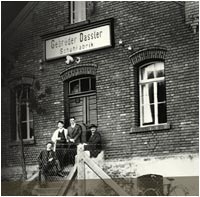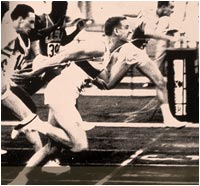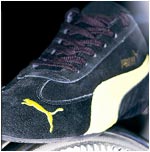 1924
to 1948: The road that led to the PUMA shoe factory owned by Rudolf Dassler 1924
to 1948: The road that led to the PUMA shoe factory owned by Rudolf Dassler
1924 - Brothers Rudolf and Adolf Dassler found the company
“Gebrüder Dassler Schuhfabrik” [Dassler Brothers Shoe Factory]
in Herzogenaurach, Germany.
1936 - Jesse Owens wins four gold medals at the Olympic Games
wearing the Dassler shoes. Overall, numerous world class athletes sporting
Dassler shoes win seven gold and five bronze medals as well as breaking two
world and five Olympic records.
 1948
- Rudolf Dassler founds PUMA Schuhfabrik Rudolf Dassler [Rudolf
Dassler shoe factory]. It is officially registered on October 1, 1948. The same
year, PUMA’s first football boot, the “ATOM”, is launched on
the market. 1948
- Rudolf Dassler founds PUMA Schuhfabrik Rudolf Dassler [Rudolf
Dassler shoe factory]. It is officially registered on October 1, 1948. The same
year, PUMA’s first football boot, the “ATOM”, is launched on
the market.
The 1950s: Sports Achievements
Shortly after the company is founded, Rudolf Dassler successfully develops a
football boot with screw-in studs, in collaboration with experts, such as Sepp
Herberger. The launch of the “SUPER ATOM,” the world’s first
screw-in boot, which Dassler launches in 1952, marks the beginning of a
long-term and highly successful relationship between PUMA and football. In May
1954, the German premier league team Hannover 96 wins the league
and are crowned champions in the final game  against
FC Kaiserslautern. The majority of the players is wearing the enhanced version
of the boot, called “BRASIL.” PUMA is also successful in track and
field: 1954 - Heinz Fütterer breaks the world record in
the 100 meters in Japan, wearing PUMA running shoes. 1958 -
PUMA introduces its trademark logo, the unmistakable PUMA form strip. In the
same year, at the Football World Cup in Sweden, the PUMA boot is worn by
players on both teams and is the only German-made football boot in the final. against
FC Kaiserslautern. The majority of the players is wearing the enhanced version
of the boot, called “BRASIL.” PUMA is also successful in track and
field: 1954 - Heinz Fütterer breaks the world record in
the 100 meters in Japan, wearing PUMA running shoes. 1958 -
PUMA introduces its trademark logo, the unmistakable PUMA form strip. In the
same year, at the Football World Cup in Sweden, the PUMA boot is worn by
players on both teams and is the only German-made football boot in the final.
The 1960s: Revolutionary Technologies
1960 – PUMA partner Armin Hary continues the company's
success story in track and field and wins gold in the 100 meters at the Olympic
Games in Rome.
 1968
- The “MEXICO 1968” running shoe amazes with its
innovative brush soles – 68 small, only 4 mm long bristles in the front
area of the foot: Numerous American athletes, who wear the shoe, set new world
records just a few weeks prior to the games in Mexico. However, according to
the association, the shoe is “too dangerous” and consequently
banned. The athletes are deprived of the world records. Nonetheless, PUMA
athlete Tommie Smith wins gold in the 200 meters and causes a stir: He and his
team colleague John Carlos (bronze) raise their fists in the Black Power
salute, protesting against discrimination of African Americans and other
minorities in the USA, Apartheid and racism. In the meantime, PUMA 1968
- The “MEXICO 1968” running shoe amazes with its
innovative brush soles – 68 small, only 4 mm long bristles in the front
area of the foot: Numerous American athletes, who wear the shoe, set new world
records just a few weeks prior to the games in Mexico. However, according to
the association, the shoe is “too dangerous” and consequently
banned. The athletes are deprived of the world records. Nonetheless, PUMA
athlete Tommie Smith wins gold in the 200 meters and causes a stir: He and his
team colleague John Carlos (bronze) raise their fists in the Black Power
salute, protesting against discrimination of African Americans and other
minorities in the USA, Apartheid and racism. In the meantime, PUMA
makes more history in football. The world class football players Eusébio
and Pélé are equipped with PUMA boots and PUMA develops the
legendary “PUMA KING” football boot.
 The
1970’s: Passion for sports The
1970’s: Passion for sports
During the World Cup in Mexico in 1970, the “Player of
the Tournament,” Pélé leads Brazil to win the title wearing
“PUMA KING.” Four years later, Johan Cruyff shows his loyalty
towards his sponsor by tearing off the third stripe of his shirt, is named the
“Player of the Tournament” and “European Player of the
Year” for the second time in a row. Even in tennis PUMA has established a
reputation:
 1977
- The Argentinean Guillermo Vilas wins the French, US and Australian
Open. 1977
- The Argentinean Guillermo Vilas wins the French, US and Australian
Open.
The 1980’s: Dynamics and Top Performances
The 80’s are dominated by the tennis boom, triggered by Boris Becker and
his spectacular victory in Wimbledon in 1985. As the youngest,
first unseeded and German player, he wins the tournament, wearing PUMA shoes
and sporting a PUMA racket. From 1984 to 1987, PUMA also has
Martina Navratilova under contract, one of the most successful players in
tennis history. In the world of football, one player was making the headlines:
Diego Armando Maradona sports PUMA boots during his first World Cup appearance
in 1982 and went down in history with the “Hand of
God” goal at the World Cup 1986.
 The
1990’s: Pastures New The
1990’s: Pastures New
In 1990, PUMA KING player Lothar Matthäus is crowned
World Cup Champion with the German National Team in Italy. The team captain is
also named “European Player of the Year,” “World Cup
Footballer,” “World Athlete” and “ARD Top Goal Scorer
of the Year.” In 1993, top athletes Heike Drechsler,
Merlene Ottey, Linford Christie and Colin Jackson win gold medals in track and
field at the World Championship in Stuttgart. At the Olympic Games 1996
PUMA causes a stir with a creative contact lens campaign. PUMA is the first
sports brand to combine sports with fashion as it enters into a collaborative
agreement with fashion designer Jil Sander in 1998.
2000 - 2009: Moving forward with Sportlifestlye
 In
the 21st century, PUMA has constantly set new trends and expanded its brand in
the most spectacular ways: As a professional equipment supplier in motorsports
(Ferrari, Renault), through cooperation agreements in design and fashion (e.g.
Yasuhiro Mihara), with sensational football shirts for the Cameroon national
football team (sleeveless and one piece), as the supplier of the Jamaican track
and field team, as the sponsor of the 2006 World Cup Champions
(Italy) and as a supplier of golf fashion. In 2008, PUMA sets
sails for the first time by entering its own sailing yacht into the Volvo Ocean
Race, one of the longest and hardest sailing races in the world and finishes
the race in second place. At the 2009 World Championships in
Athletics, PUMA again writes sport history: sprint hero Usain Bolt smashes the
100m and 200m world records. In
the 21st century, PUMA has constantly set new trends and expanded its brand in
the most spectacular ways: As a professional equipment supplier in motorsports
(Ferrari, Renault), through cooperation agreements in design and fashion (e.g.
Yasuhiro Mihara), with sensational football shirts for the Cameroon national
football team (sleeveless and one piece), as the supplier of the Jamaican track
and field team, as the sponsor of the 2006 World Cup Champions
(Italy) and as a supplier of golf fashion. In 2008, PUMA sets
sails for the first time by entering its own sailing yacht into the Volvo Ocean
Race, one of the longest and hardest sailing races in the world and finishes
the race in second place. At the 2009 World Championships in
Athletics, PUMA again writes sport history: sprint hero Usain Bolt smashes the
100m and 200m world records.
2010: Africa at the Centre of the Football World
 The
year 2010 will be marked by the Football World Cup in Africa,
PUMA’s home-away-fromhome. PUMA successfully kicks off the World Cup year
at the Africa Cup in Angola: in an all-PUMA final, Egypt’s Pharaohs beat
Ghana and win the Cup of Nations for the sixth time. The sportlifestyle company
has enjoyed more than a decade of close partnerships and collaborations with
African football federations and is the sponsor of 13 African national football
teams. The
year 2010 will be marked by the Football World Cup in Africa,
PUMA’s home-away-fromhome. PUMA successfully kicks off the World Cup year
at the Africa Cup in Angola: in an all-PUMA final, Egypt’s Pharaohs beat
Ghana and win the Cup of Nations for the sixth time. The sportlifestyle company
has enjoyed more than a decade of close partnerships and collaborations with
African football federations and is the sponsor of 13 African national football
teams.
|














